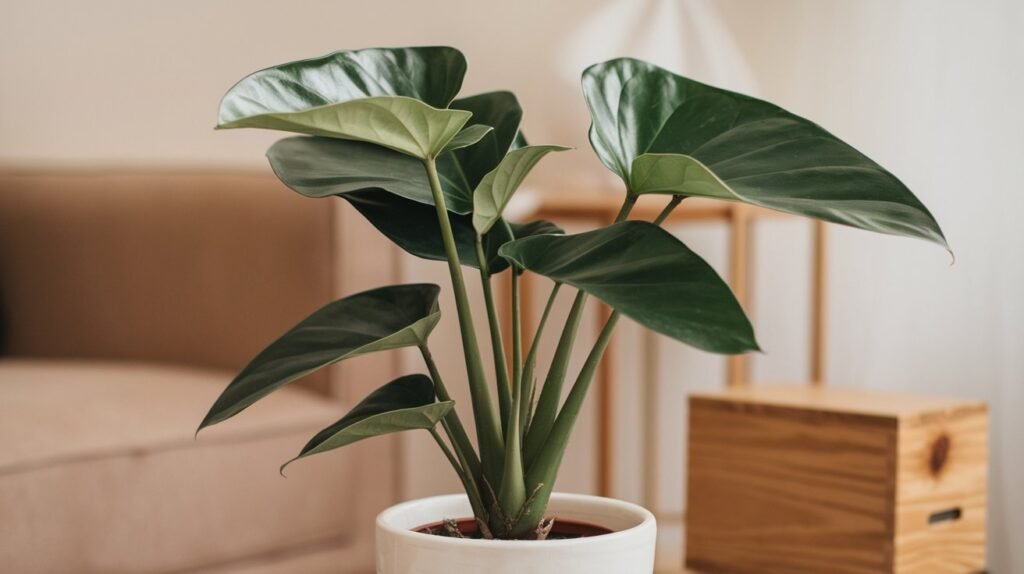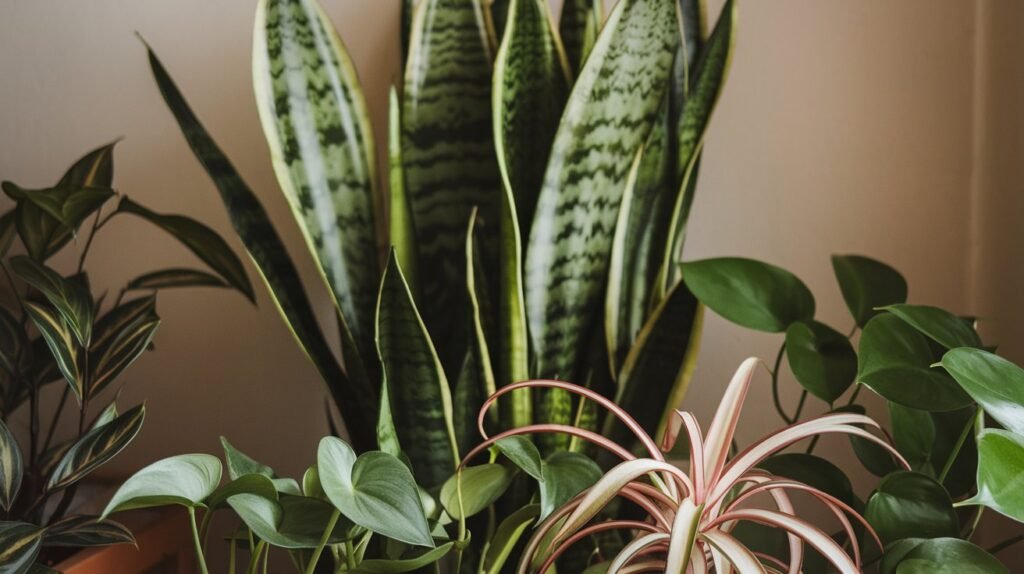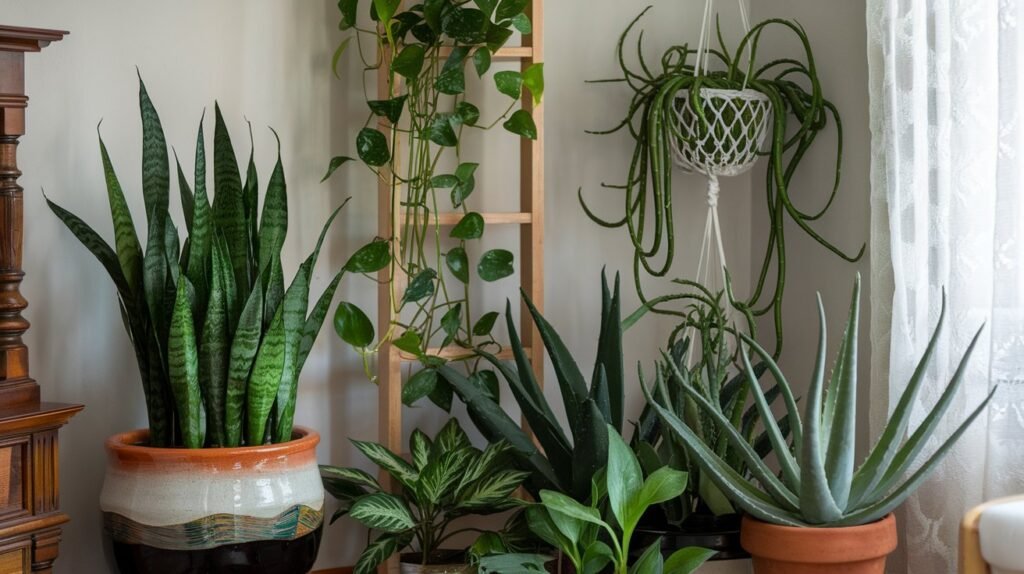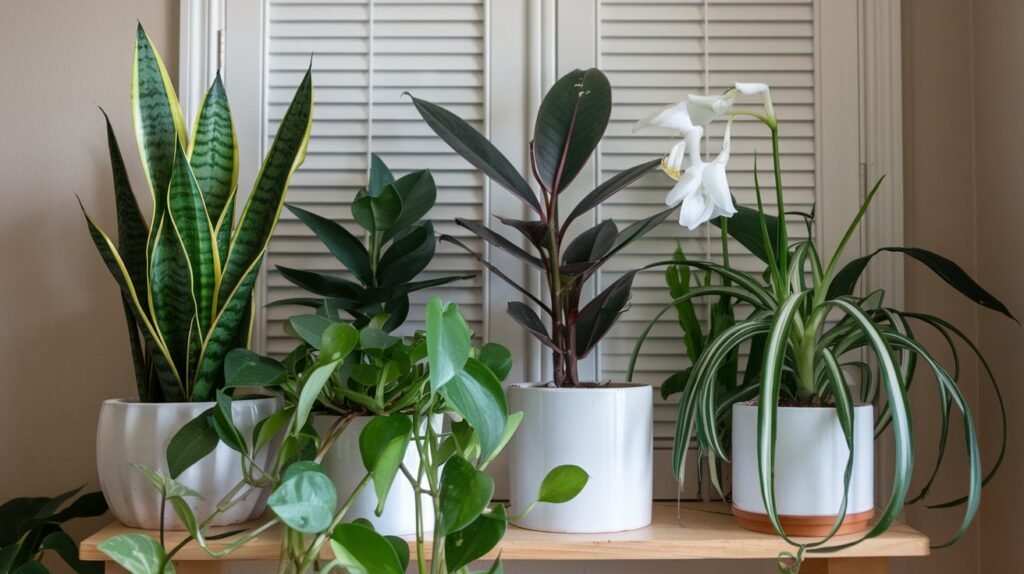Indoor plants are more than just pretty decor. They bring life to your home while offering a host of benefits, including stress reduction, humidity regulation, and, most notably, air purification. If you’re looking to freshen up your space, reduce airborne toxins, and create a healthier indoor environment, this guide to the best air-purifying plants is your ultimate resource.
Ready to turn your home into a green oasis? Let’s dive in! And don’t forget to check out our balcony gardening ideas or sustainable living hacks for more eco-friendly inspiration.

Why Indoor Air Quality Matters
We often think of air pollution as an outdoor problem, but indoor air can be just as bad—or even worse—due to volatile organic compounds (VOCs) emitted by furniture, cleaning products, and other household items. Poor air quality can lead to headaches, allergies, fatigue, and long-term health issues.
NASA’s famous Clean Air Study highlighted how certain houseplants can reduce VOCs and other toxins, making them nature’s air filters. The best part? Many of these plants are easy to care for and thrive indoors.

Top Air-Purifying Indoor Plants
Here’s a list of the best plants that not only beautify your home but also improve air quality.
1. Peace Lily (Spathiphyllum)
- Air-Cleansing Powers: Peace lilies are excellent at removing toxins like benzene, formaldehyde, and ammonia.
- Care Tips: These beauties thrive in low light and need watering about once a week. Just be cautious if you have pets, as they are toxic when ingested.
- Bonus: Peace lilies bloom frequently, adding a touch of elegance to any room.
2. Snake Plant (Sansevieria)
- Air-Cleansing Powers: Also known as mother-in-law’s tongue, this hardy plant filters out carbon dioxide and toxins like benzene and xylene.
- Care Tips: Snake plants are nearly indestructible. They prefer bright, indirect light but can survive in low light. Water sparingly.
- Bonus: It’s one of the best plants for nighttime oxygen release, making it ideal for bedrooms.
3. Spider Plant (Chlorophytum comosum)
- Air-Cleansing Powers: Spider plants are masters at removing carbon monoxide and formaldehyde.
- Care Tips: They’re perfect for beginners, as they’re forgiving and thrive in indirect sunlight. Water when the soil is dry.
- Bonus: Spider plants produce adorable “babies” that you can propagate and share with friends.
4. Boston Fern (Nephrolepis exaltata)
- Air-Cleansing Powers: Boston ferns are great for increasing humidity and removing pollutants like formaldehyde and xylene.
- Care Tips: They prefer cooler temperatures, high humidity, and indirect sunlight. Keep the soil moist but not soggy.
- Bonus: This lush plant adds a tropical vibe to any space.
5. Areca Palm (Dypsis lutescens)
- Air-Cleansing Powers: Areca palms remove carbon monoxide, benzene, and formaldehyde while acting as a natural humidifier.
- Care Tips: These palms love bright, indirect light and regular watering. Avoid overwatering to prevent root rot.
- Bonus: Their graceful fronds make them a stunning centerpiece in living rooms or offices.
6. Aloe Vera
- Air-Cleansing Powers: Aloe vera removes benzene and formaldehyde, making it a dual-purpose plant for air purification and skincare.
- Care Tips: Aloe thrives in bright, indirect light and requires minimal watering—perfect for those with a busy lifestyle.
- Bonus: Snap off a leaf to use the gel for burns, cuts, or skincare treatments.
7. Rubber Plant (Ficus elastica)
- Air-Cleansing Powers: Rubber plants effectively remove carbon monoxide, formaldehyde, and other toxins.
- Care Tips: They prefer medium to bright indirect light and need watering once the top inch of soil is dry.
- Bonus: With their large, glossy leaves, rubber plants are a statement piece in any home.
8. English Ivy (Hedera helix)
- Air-Cleansing Powers: English ivy reduces airborne mold and allergens, making it a great choice for people with allergies.
- Care Tips: This vine thrives in bright, indirect light and needs consistent watering to stay healthy.
- Bonus: It can be grown in hanging baskets or trained to climb for a decorative touch.
9. Dracaena
- Air-Cleansing Powers: Dracaenas tackle pollutants like benzene, trichloroethylene, and xylene.
- Care Tips: These striking plants prefer low to medium light and moderate watering. Allow the soil to dry slightly between waterings.
- Bonus: With various types like the red-edged and corn plant, dracaenas offer plenty of design flexibility.
10. Pothos (Epipremnum aureum)
- Air-Cleansing Powers: Pothos is effective against VOCs like benzene, formaldehyde, and toluene.
- Care Tips: Known for being low-maintenance, pothos thrives in almost any lighting condition. Water when the soil feels dry.
- Bonus: Its trailing vines are perfect for hanging baskets or training along shelves.
How to Maximize Air Purification with Indoor Plants

- Use Multiple Plants
For optimal air purification, aim for one plant per 100 square feet of space. - Place Plants Strategically
Put plants near areas with poor ventilation, such as bathrooms or basements, to maximize their impact. - Dust Leaves Regularly
Dust can block pores on leaves, reducing their ability to absorb toxins. Wipe them down with a damp cloth periodically. - Consider Plant Combinations
Mixing different types of air-purifying plants can tackle a broader range of pollutants.
The Added Benefits of Indoor Plants
Aside from purifying the air, indoor plants can:
- Boost your mood and productivity.
- Reduce stress levels.
- Improve humidity levels, making the air more comfortable to breathe.
These benefits make them perfect for homes, offices, and even small spaces like dorm rooms.
Making It Sustainable

Incorporating plants into your home can also be part of a larger sustainable living strategy. For instance:
- Use repurposed containers like old jars or tins as pots.
- Recycle water from cooking (cooled, of course!) to hydrate your plants.
- Combine your indoor plant care routine with other eco-friendly projects, like balcony gardening, to create a self-sustaining green haven.
Final Thoughts
Transforming your home with air-purifying plants is a simple, cost-effective way to enhance your living space and improve your health. From hardy snake plants to lush Boston ferns, there’s a plant for every lifestyle and skill level. Plus, incorporating greenery into your home aligns perfectly with sustainable living practices, making your indoor garden a win-win for you and the environment.
Ready to start your air-purifying journey? Pick a plant (or a few), grab a pot, and let nature do the rest! For more inspiration, explore our tips on sustainable living hacks or learn how to make the most of small spaces with balcony gardening ideas. 🌱







